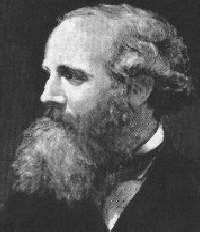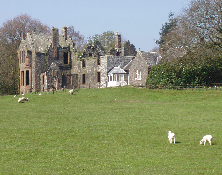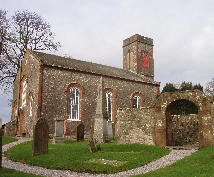

The year 2005 will see many events throughout the world to celebrate the World Year of Physics and in particular to mark the 100th anniversary of the discoveries of Albert Einstein. Already I have seen two television programmes since the start of the year dedicated to and depicting his life. But Einstein’s work may not have been possible without the foundations laid down in the mid 19th century by a scientist of equal status, James Clerk Maxwell who hailed from Glenlair in the heart of Bonnie Galloway in Southwest Scotland. Although not as well known as he deserves to be in his own country, his name is probably more familiar throughout the rest of the world. For someone who has a crater named after him on the Moon, there have been few tangible signs of recognition of this man until fairly recently. As G3EFY states in his excellent article “IN RETROSPECT” (November 2004 edition of MERCURY, the Journal of the Royal Signal’s Amateur Radio Society, number 139) “Marconi is well known to most of us but those other men of knowledge may not be so familiar”. And the first highlighted in the article is James Clerk Maxwell and it goes on to say,”His mathematical theory of electromagnetic radiation, published in 1873, was the foundation upon which communication without wires was to become a reality.”
Although born at 14 India Street, Edinburgh on 13 June 1831, he was only a few months old when he was taken to Glenlair to live on the family estate in Galloway. The house of Glenlair was built by his father John, and is situated about seven miles north of Castle Douglas near the village of Corsock. This is where Maxwell was to spend his formative years and he had a lifelong affection for the area. He later extended the house in 1867 and even when demands on his time as an academic were considerable, he would try and spend up to six months of the year there. Sadly the house was badly damaged by fire in 1929 and has suffered severely from weather and neglect. Its crumbling walls and leaning chimneys is a prominent landmark for people as they pass by on the B794 road from Dalbeattie to Corsock. But the present owner Captain R Duncan Ferguson, has established the Maxwell At Glenlair Trust to stabilise the building and set up a permanent monument to the scientist. Captain Ferguson also plans a display about Maxwell in the restored porch that was part of the extension built by Maxwell, and many of the original features from his time are still intact.
Tragically, when only eight, his mother died from abdominal cancer and young James was taken back to Edinburgh where he had an extended family, especially among caring aunts. James went to Edinburgh Academy and this is where his extraordinary scientific ability began to show. At school he was at first regarded as shy and rather dull. He made no friendships and spent his occasional holidays in reading old ballads, drawing curious diagrams and making rude mechanical models. This absorption in such pursuits, totally unintelligible to his schoolfellows, who were then totally ignorant of mathematics, procured him a not complimentary nickname “Dafty”. About the middle of his school career however he surprised his companions by suddenly becoming one of the most brilliant among them, gaining prizes and sometimes the highest prizes for scholarship, mathematics, and English verse. Whilst still at school and aged only 14, a scientific paper written by him on ovals was presented to the prestigious Royal Society of Edinburgh, although it had to be read by someone else, as he was considered too young. He went on to Edinburgh University where it became apparent that his talent made an academic career inevitable. In 1850 he moved from Edinburgh University to Trinity College, Cambridge, co-incidentally the same College attended by Sir Isaac Newton, the scientist he would emulate. Although James continued to distinguish himself and became a Fellow of Trinity College, there was not the indication of the scale of the great discoveries to come. However, one of Maxwell’s most important achievements was his extension and mathematical formulation of Michael Faraday’s theories of electricity and magnetic lines of force and his paper On Faraday’s lines of force was read to the Cambridge Philosophical Society in two parts, 1855 and 1856. Maxwell showed that a few relatively simple mathematical equations could express the behaviour of electric and magnetic fields and their interrelation.
Maxwell’s father became ill and Maxwell wanted to spend more time with him by returning to Scotland. He applied for the post of Professor of Natural Philosophy at Marischal College in Aberdeen. His father died on 3 April 1856 and by the end of that month he learned that he had been appointed to the chair at Marischal College and subsequently took up his appointment in November 1856. When the subject announced by St John’s College Cambridge for the Adams Prize of 1857 was The Motion of Saturn’s Rings Maxwell was immediately interested and decided to compete for the prize and his research at Aberdeen in his first two years was taken up with this topic. He showed that stability could be achieved only if rings consisted of numerous small particles, an explanation now confirmed by the Voyager spacecraft. Maxwell essay won him the Adam’s Prize and Airy said “it is one of the most remarkable applications of mathematics to physics that I have ever seen”
In 1859 he married Katherine Dewar, the daughter of the Dean to Marischal College, Aberdeen and he was to remain devoted to her for the rest of his life. Despite what some might consider the smart move of marrying the boss’s daughter, Maxwell was to lose his job. Marischal and King’s Colleges were to be merged and there was to be only one Professor of Natural Philosophy. Maxwell, as the junior of the department, had to seek another post.
In 1860, therefore, one of the most brilliant brains in Scotland found himself out of work. He retreated to his beloved Glenlair but his unemployment didn’t last long and by the end of the year he was appointed Professor of Physics and Astronomy at King’s College, London. The six years spent in this post were the years when he did his most important experimental work. In 1861 there was the most amazing presentation, years ahead of its time. At the Royal Institution in London, Maxwell demonstrated the first colour photograph. It showed his complete theoretical appreciation of light and what made up colour. It was to be the 20th century before the technology caught up the theory and his principles were applied! Appropriately because of his Scottish background, Maxwell used a tartan ribbon for the demonstration. He photographed the ribbon three separate times through red green and blue filters. The three photographs were then projected through the same filters and when they were overlapped, the ribbon miraculously appeared in all its colours. This was to be the basis of future colour photography and in a remarkable combination of Maxwell’s interests, the Cassini spacecraft is currently using Maxwell’s technique with filters to send back extremely accurate colour pictures of Saturn and its rings.
Maxwell left King’s College, London in the spring of 1865 and returned once again to his Scottish estate Glenlair. He made periodic trips to Cambridge and, rather reluctantly, accepted an offer from Cambridge to be the Cavendish Professor of Physics in 1871. He designed the Cavendish laboratory and helped set it up and the Laboratory was formally opened on 16 June 1874.
But it was between 1856 and 1873 that Maxwell was working on his greatest discovery and which was to make his name throughout the world of science – electro magnetic fields. Michael Faraday had carried out practical experiments with magnetism and it was those Maxwell was to transform. Because of his brilliance as a mathematician he made “one of the greatest leaps ever made in human thought” to produce a comprehensive theory of electricity and magnetism with equations which would predict what would happen in any circumstances, even in space. Those are known as the Maxwell equations that are still in use. Maxwell showed that these equations implicitly required the existence of electromagnetic waves.
Maxwell did for the difficult subjects of electricity and magnetism what Sir Isaac Newton had done for force and motion, creating the basis for modern electrical theory. Maxwell’s equations “rank equally with Newton’s equations of motion”. In the 20th Century Albert Einstein was to pay tribute by saying that his “Special Theory of Relativity owes its origins of Maxwell’s equations of the electromagnetic field”.
In 1864 Maxwell presented his paper “A Dynamic Theory Of The Electro-magnetic Field” to the Royal Society in London. It is claimed to be “the most important event in the 19th Century in the history of physical sciences”. The importance of the work was not immediately obvious to his contemporaries and, not surprisingly, it was complicated and difficult, even for other eminent scientists to comprehend fully. The level of understanding had not improved eight years later when in 1873 Maxwell produced his classic handbook Treatise On Electricity and Magnetism.
It was during a visit to Cambridge from Glenlair that Maxwell died on 5 November 1879. Tragically his life was cut short and he died of the same illness (abdominal cancer) and at the same age as his mother. He was only 48 years old but he left an immense scientific legacy. His wife who also suffered poor health did not survive him by many years and they are buried together with Maxwell’s parents at Parton Churchyard. Parton village is attractively situated beside Loch Ken approximately 6 miles north-west of Castle Douglas on the A713 Castle Douglas to Ayr road. The simple gravestone at Parton Church is well visited and there is a bronze memorial plaque erected outside the churchyard. The dedication to Maxwell reads:
His short life was rich in distinguished contributions to every branch of physical science – heat, light mechanics. Above all by unifying the theories of electricity and magnetism he established a sure foundation for modern physics, electrical engineering, and prepared the way for radio communication and television.
I first discovered this plaque whilst sitting in my car and taking part in a Dumfries and Galloway Raynet Group exercise a few years ago The event was the local Crossmichael Marathon for Charity and my two metre mobile station was located in the lay-by at Parton Church immediately adjoining the location of the plaque. At that point in time fully appreciated just what this Gallovidian had done for our hobby of Amateur Radio. Thank you James Clerk Maxwell .
Tragically, when only eight, his mother died from abdominal cancer and young James was taken back to Edinburgh where he had an extended family, especially among caring aunts. James went to Edinburgh Academy and this is where his extraordinary scientific ability began to show. At school he was at first regarded as shy and rather dull. He made no friendships and spent his occasional holidays in reading old ballads, drawing curious diagrams and making rude mechanical models. This absorption in such pursuits, totally unintelligible to his schoolfellows, who were then totally ignorant of mathematics, procured him a not complimentary nickname “Dafty”. About the middle of his school career however he surprised his companions by suddenly becoming one of the most brilliant among them, gaining prizes and sometimes the highest prizes for scholarship, mathematics, and English verse. Whilst still at school and aged only 14, a scientific paper written by him on ovals was presented to the prestigious Royal Society of Edinburgh, although it had to be read by someone else, as he was considered too young. He went on to Edinburgh University where it became apparent that his talent made an academic career inevitable. In 1850 he moved from Edinburgh University to Trinity College, Cambridge, co-
Maxwell’s father became ill and Maxwell wanted to spend more time with him by returning to Scotland. He applied for the post of Professor of Natural Philosophy at Marischal College in Aberdeen. His father died on 3 April 1856 and by the end of that month he learned that he had been appointed to the chair at Marischal College and subsequently took up his appointment in November 1856. When the subject announced by St John’s College Cambridge for the Adams Prize of 1857 was The Motion of Saturn’s Rings Maxwell was immediately interested and decided to compete for the prize and his research at Aberdeen in his first two years was taken up with this topic. He showed that stability could be achieved only if rings consisted of numerous small particles, an explanation now confirmed by the Voyager spacecraft. Maxwell essay won him the Adam’s Prize and Airy said “it is one of the most remarkable applications of mathematics to physics that I have ever seen”
In 1859 he married Katherine Dewar, the daughter of the Dean to Marischal College, Aberdeen and he was to remain devoted to her for the rest of his life. Despite what some might consider the smart move of marrying the boss’s daughter, Maxwell was to lose his job. Marischal and King’s Colleges were to be merged and there was to be only one Professor of Natural Philosophy. Maxwell, as the junior of the department, had to seek another post.
In 1860, therefore, one of the most brilliant brains in Scotland found himself out of work. He retreated to his beloved Glenlair but his unemployment didn’t last long and by the end of the year he was appointed Professor of Physics and Astronomy at King’s College, London. The six years spent in this post were the years when he did his most important experimental work. In 1861 there was the most amazing presentation, years ahead of its time. At the Royal Institution in London, Maxwell demonstrated the first colour photograph. It showed his complete theoretical appreciation of light and what made up colour. It was to be the 20th century before the technology caught up the theory and his principles were applied! Appropriately because of his Scottish background, Maxwell used a tartan ribbon for the demonstration. He photographed the ribbon three separate times through red green and blue filters. The three photographs were then projected through the same filters and when they were overlapped, the ribbon miraculously appeared in all its colours. This was to be the basis of future colour photography and in a remarkable combination of Maxwell’s interests, the Cassini spacecraft is currently using Maxwell’s technique with filters to send back extremely accurate colour pictures of Saturn and its rings.
Maxwell left King’s College, London in the spring of 1865 and returned once again to his Scottish estate Glenlair. He made periodic trips to Cambridge and, rather reluctantly, accepted an offer from Cambridge to be the Cavendish Professor of Physics in 1871. He designed the Cavendish laboratory and helped set it up and the Laboratory was formally opened on 16 June 1874.
But it was between 1856 and 1873 that Maxwell was working on his greatest discovery and which was to make his name throughout the world of science – electro magnetic fields. Michael Faraday had carried out practical experiments with magnetism and it was those Maxwell was to transform. Because of his brilliance as a mathematician he made “one of the greatest leaps ever made in human thought” to produce a comprehensive theory of electricity and magnetism with equations which would predict what would happen in any circumstances, even in space. Those are known as the Maxwell equations that are still in use. Maxwell showed that these equations implicitly required the existence of electromagnetic waves.
Maxwell did for the difficult subjects of electricity and magnetism what Sir Isaac Newton had done for force and motion, creating the basis for modern electrical theory. Maxwell’s equations “rank equally with Newton’s equations of motion”. In the 20th Century Albert Einstein was to pay tribute by saying that his “Special Theory of Relativity owes its origins of Maxwell’s equations of the electromagnetic field”.
In 1864 Maxwell presented his paper “A Dynamic Theory Of The Electro-
His short life was rich in distinguished contributions to every branch of physical science – heat, light mechanics. Above all by unifying the theories of electricity and magnetism he established a sure foundation for modern physics, electrical engineering, and prepared the way for radio communication and television.
I first discovered this plaque whilst sitting in my car and taking part in a Dumfries and Galloway Raynet Group exercise a few years ago The event was the local Crossmichael Marathon for Charity and my two metre mobile station was located in the lay-
Portrait of James Clerk Maxwell



Glenlair House (left), Parton Church (Centre) Maxwell’s Grave

OR
to take you to an extended article about James Clerk Maxwell in downloadable .PDF format




